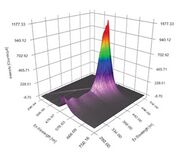Difference between revisions of "Excitation emission matrix (EEM)"
(Created page with "== Description == The Excitation Emission Matrix (EEM) is a specific measurement that is becoming more and more respected and widely used within the field of fluorescence spec...") |
|||
| Line 1: | Line 1: | ||
| + | [[File:Excitation Emission Matrix Horiba.jpg|thumb|Exictation Emission Matrix plot<br> Horiba: [https://www.horiba.com/int/scientific/technologies/fluorescence-spectroscopy/what-is-an-excitation-emission-matrix-eem/ EEM]]] | ||
== Description == | == Description == | ||
| − | The Excitation Emission Matrix (EEM) is a specific measurement that is becoming more | + | The Excitation Emission Matrix (EEM) is a specific measurement that is becoming more widely used within the field of fluorescence spectroscopy. An EEM compilation is essentially a three dimensional scan that results in a contour plot of excitation wavelength vs. emission wavelength vs. fluorescence intensity. |
A type of electromagnetic spectroscopy that analyzes fluorescence from a sample. Fluorescence spectroscopy involves using a beam of light, usually ultraviolet light, that excites the electrons in molecules of certain compounds and causes them to emit light; typically, but not necessarily, visible light. A complementary technique is [[absorption spectroscopy]]. | A type of electromagnetic spectroscopy that analyzes fluorescence from a sample. Fluorescence spectroscopy involves using a beam of light, usually ultraviolet light, that excites the electrons in molecules of certain compounds and causes them to emit light; typically, but not necessarily, visible light. A complementary technique is [[absorption spectroscopy]]. | ||
| Line 12: | Line 13: | ||
==Resources and Citations== | ==Resources and Citations== | ||
* Wikipedia: [https://en.wikipedia.org/wiki/Fluorescence_spectroscopy Fluorescence spectroscopy] | * Wikipedia: [https://en.wikipedia.org/wiki/Fluorescence_spectroscopy Fluorescence spectroscopy] | ||
| − | + | * Horiba: [https://www.horiba.com/int/scientific/technologies/fluorescence-spectroscopy/what-is-an-excitation-emission-matrix-eem/ EEM] | |
[[Category:Materials database]] | [[Category:Materials database]] | ||
Revision as of 14:38, 21 June 2023
Description
The Excitation Emission Matrix (EEM) is a specific measurement that is becoming more widely used within the field of fluorescence spectroscopy. An EEM compilation is essentially a three dimensional scan that results in a contour plot of excitation wavelength vs. emission wavelength vs. fluorescence intensity.
A type of electromagnetic spectroscopy that analyzes fluorescence from a sample. Fluorescence spectroscopy involves using a beam of light, usually ultraviolet light, that excites the electrons in molecules of certain compounds and causes them to emit light; typically, but not necessarily, visible light. A complementary technique is Absorption spectroscopy.
In a typical fluorescence (emission) measurement, the excitation wavelength is fixed and the detection wavelength varies, while in a fluorescence excitation measurement the detection wavelength is fixed and the excitation wavelength is varied across a region of interest. An emission map is measured by recording the emission spectra resulting from a range of excitation wavelengths and combining them all together. This is a three dimensional surface data set: emission intensity as a function of excitation and emission wavelengths, and is typically depicted as a contour map.
Synonyms and Related Terms
EEM; Excitation-emission matrix spectroscopy; Flourescence spectroscopy; fluorimetry; spectrofluorometry
Resources and Citations
- Wikipedia: Fluorescence spectroscopy
- Horiba: EEM
